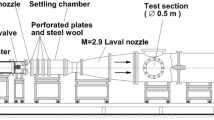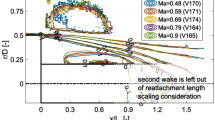Abstract
The wake flow of a generic axisymmetric space-launcher model is investigated experimentally for flow cases with and without propulsive jet to gain insight into the wake-flow phenomena at a supersonic stage of the flight trajectory which is especially critical with respect to dynamic loads on the structure. Measurements are performed at Mach 2.9 and a Reynolds number Re D = 1.3 × 106 based on model diameter D. The nozzle exit velocity of the jet is at Mach 2.5, and the flow is moderately underexpanded (p e/p ∞ = 5.7). The flow topology is described based on velocity measurements in the wake by means of particle image velocimetry and schlieren visualizations. Mean and fluctuating mass-flux profiles are obtained from hot-wire measurements, and unsteady wall-pressure measurements on the main-body base are performed simultaneously. This way, the evolution of the wake flow and its spectral content can be observed along with the footprint of this highly dynamic flow on the launcher main-body base. For the case without propulsive jet, a large separated zone is forming downstream of the main body shoulder, and the flow is reattaching further downstream on the afterbody. The afterexpanding propulsive jet (air) causes a displacement of the shear layer away from the wall, preventing the reattachment of the flow. In the spectral analysis of the baseline case, a dominant frequency around St D = 0.25 is found in the pressure-fluctuation signal at the main-body base of the launcher. This frequency is related to the shedding of the separation bubble and is less pronounced in the presence of the propulsive jet. In the shear layer itself, the spectra obtained from the hot-wire signal have a more broadband low-frequency content, which also reflects the characteristic frequency of turbulent structures convected in the shear layer, a swinging motion (St D = 0.6), as well as the radial flapping motion of the shear layer (St D = 0.85), respectively. Moving downstream along the shear layer, spectral content at slightly higher frequencies (St D < 4) gets more pronounced and can be related to the shear layer instability process and the signature of smaller turbulent structures that appear in the wake.

Figure from Statnikov et al. [20]














Similar content being viewed by others
Abbreviations
- D :
-
Model main-body diameter
- d :
-
Diameter
- f :
-
Frequency
- M :
-
Mach number
- p :
-
Pressure
- r :
-
Radius
- Re :
-
Reynolds number
- St :
-
Strouhal number
- T :
-
Temperature
- U :
-
Mean velocity in the axial direction
- V :
-
Mean velocity in the vertical direction
- x :
-
Axial direction
- y :
-
Radial direction
- κ :
-
Specific heat ratio
- ℜ :
-
Gas constant
- δ :
-
Boundary-layer thickness
- φ :
-
Radial angle in plain of main-body base
- τ :
-
Hot-wire overheat ratio
- ρu :
-
Mass flux
- e:
-
Value at nozzle exit
- max:
-
Maximum value
- mean:
-
Mean value
- Mol:
-
Molar mass
- p :
-
Value in rocket plume
- RK:
-
Value in HLB settling chamber
- SC:
-
Value in TSA settling chamber
- SP:
-
Value in HLB storage tube
- t :
-
Absolute pressure/temperature
- ∞:
-
Value in free stream
- AoI:
-
Area of interest
- CCD:
-
Charge-coupled device
- CTA:
-
Constant temperature anemometer
- HLB:
-
Hypersonic Ludwieg tube Braunschweig
- ISM:
-
Institute of Fluid Mechanics, TU Braunschweig
- LES:
-
Large-eddy simulations
- PIV:
-
Particle image velocimetry
- PSD:
-
Power spectral density
- RANS:
-
Reynolds-averaged Navier–Stokes eq
- rms:
-
Root mean square
- TIC:
-
Truncated ideal contour
- TSA:
-
Jet-simulation facility
References
Bannink, W.J., Houtman, E.M., Bakker, P.G.: Base flow/underexpanded exhaust plume interaction in a supersonic external flow. 8th AIAA International Space Planes and Hypersonic Systems and Technology Conference, AIAA Paper 98–1598 (1998)
Berger, E., Scholz, D., Schumm, M.: Coherent vortex structures in the wake of a sphere and a circular disk at rest and under forced vibrations. J. Fluids Struct. 4, 231–257 (1990)
Bourdon, C., Dutton, J.C.: Planar visualizations of large-scale turbulent structures in axisymmetric supersonic separated flows. Phys. Fluids 11(1), 201–213 (1999)
Casper, M., Stephan, S., Scholz, P., Radespiel, R.: Qualification of oil-based tracer particles for heated Ludwieg tubes. Exp. Fluids 55, 1753 (2014)
Deck, S., Thorigny, P.: Unsteadiness of an axisymmetric separating-reattaching flow: numerical investigation. Phys. Fluids 19(6), 065103–1–065103–20 (2007)
Deprés, D., Reijasse, P., Dussauge, J.-P.: Analysis of unsteadiness in afterbody transonic flows. AIAA J. 42(12), 2541–2550 (2004)
Estorf, M., Wolf, T., Radespiel, R.: Experimental and numerical investigations on the operation of the Hypersonic Ludwieg Tube Braunschweig. In: Proceedings of the 5th European Symposium on Aerothermodynamics for Space Vehicles, pp. 579–586 (2005)
Janssen, J., Dutton, J.C.: Time-series analysis of supersonic base-pressure fluctuations. AIAA J. 42(3), 605–613 (2004)
Kiya, M., Sasaki, K.: Structure of a turbulent separation bubble. J. Fluid Mech. 137, 83–113 (1983)
Kovasznay, L.S.G.: The hot-wire anemometer in supersonic flow. J. Aeronaut. Sci. 17, 565–572 (1950)
Laufer, J., McClellan, R.: Measurements of heat transfer from fine wires in supersonic flows. J. Fluid Mech. 1, 276–289 (1956)
Lüdeke, H., Mulot, J.D., Hannemann, K.: Launch vehicle base flow analysis using improved delayed detached-Eddy simulation. AIAA J. 53(9), 2454–2471 (2015)
Piponniau, S., Dussauge, J.-P., Debiève, J.-F., Dupont, P.: A simple model for low-frequency unsteadiness in shock induced separation. J. Fluid Mech. 629, 87–108 (2009)
Saile, D., et al.: Investigations on the turbulent wake of a generic space launcher geometry in the hypersonic flow regime. In: 4th European Conference for Aerospace Sciences EUCASS (2011)
Saile, D., Guelhan, A.: Plume-induced effects on the near-wake region of a generic space launcher geometry. In: Proceedings of the 32nd AIAA Applied Aerodynamics Conference, AIAA 2014-3137 (2014)
Sippel, M., Herbertz, A.: System requirements on investigation of base flow/plume interaction. In: Gülhan, A. (ed.) RESPACE—key technologies for reusable space systems, Bd. 98. Notes on numerical fluid mechanics and multidisciplinary design, pp. 3–19. Springer, Berlin (2008). doi:10.1007/978-3-540-77819-6_2
Smits, A.J., Dussauge, J.-P.: Turbulent shear layers in supersonic flow, 2nd edn. Springer, New York (2006)
Smits, A.J., Hayakawa, K., Muck, K.-C.: Constant temperature hot-wire anemometer practice in supersonic flows: part 1: the normal wire. Exp. Fluids 1, 83–92 (1983)
Smits, A.J., Muck, K.-C.: Experimental study of three shock wave/turbulent boundary layer interactions. J. Fluid Mech. 182, 291–314 (1987)
Statnikov, V., Stephan, S., Pausch, K., Meinke, M., Radespiel, R., Schröder, W.: Experimental and numerical investigations of the turbulent wake flow of a generic space launcher at M∞ = 3 and M∞ = 6. CEAS Space J. 8(2), 101–116 (2016)
Statnikov, V., Sayadi, T., Meinke, M., Schmid, P., Schröder, W.: Analysis of pressure perturbation sources on a generic space launcher after-body in supersonic flow using zonal RANS/LES and dynamic mode decomposition. Phys. Fluids 27(1), 042103–1–024103–22 (2015)
Stephan, S., Wu, J., Radespiel, R.: Propulsive jet influence on generic launcher base flow. CEAS Space J. (2015). doi:10.1007/s12567-015-0098-9
Taneda, S.: Visual observations of the flow past a sphere at reynolds numbers between 104 and 106. J. Fluid Mech. 85(Pt. 1), 187–192 (1978)
Weiss, J.: Experimental determination of the free stream disturbance field in the short duration supersonic wind tunnel of Stuttgart University. PhD thesis, Universität Stuttgart, Germany (2002)
Weiss, P.-E., Deck, S., Robinet, J.-C., Sagaut, P.: On the dynamics of axisymmetric turbulent separating/reattaching flows. Phys. Fluids 21(7), 075103–1–075103–8 (2009)
Wu, J., Zamre, P., Radespiel, R.: Disturbance characterization and flow quality improvement in a tandem nozzle Mach 3 wind tunnel. Exp. Fluids 56(20), 1–18 (2015)
Acknowledgments
The German Research Foundation DFG is gratefully acknowledged for funding this research in the framework of the Transregional Collaborative Research Center SFB-TR40 “Technological foundations for the design of thermally and mechanically highly loaded components of future space transportation systems”.
Author information
Authors and Affiliations
Corresponding author
Rights and permissions
About this article
Cite this article
Schreyer, AM., Stephan, S. & Radespiel, R. Characterization of the supersonic wake of a generic space launcher. CEAS Space J 9, 97–110 (2017). https://doi.org/10.1007/s12567-016-0134-4
Received:
Revised:
Accepted:
Published:
Issue Date:
DOI: https://doi.org/10.1007/s12567-016-0134-4




